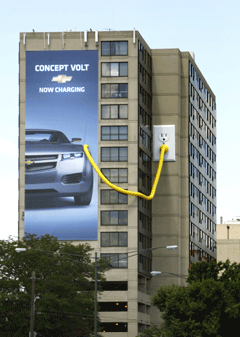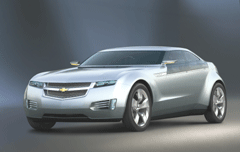Car of the Future
Air Date: Week of November 9, 2007

(Courtesy of Chevrolet)
Chevrolet ran advertisements for the hybrid electric Chevy Volt during this year’s World Series. But the Volt won’t be available until 2010. Jerry Garrett writes for the New York Times automotive section and tells Bruce Gellerman that he wonders whether the Volt will ever make it to the showroom floor. LOE then speaks with Chevrolet Director of Communications Terry Rhadigan, who says getting the Volt on the road is a top priority.
Transcript
GELLERMAN: Carmakers are gearing up for the L.A, Auto Show. It happens in mid-November. That’s when manufacturers go full throttle putting on the glitz and glamour to create buzz, with a capital B. Or this time around, should I say capital V? That’s ‘V’ for Volt. The Chevy Volt is one of the most anticipated cars in years. While the average U.S.-made car today gets about the same mileage as Henry Ford’s Model T, the Volt gets great MPGs and produces little in the way of greenhouse gases. It’s a sleek, full-size, plug-in electric hybrid with a small flex-fuel engine. Maybe you caught one of the ads for the Volt that ran during the recent World Series.
[VOLT AD FADES IN, MAN SAYS ‘DO YOU HEAR THAT?’ BOYS SAYS ‘IT’S HUMMING,’ MAN SAYS ‘OH, THAT’S NO ORDINARY HUM, THAT’S THE SOUND OF THE FUTURE. THE EXTENDED RANGE ELECTRIC CAR POWERED BY THE MIRACLE OF THE ADVANCED LITHIUM ION BATTERY PACK,’ BOY SAYS ‘HUH?’ MAN SAYS ‘YOU PLUG IT IN. AND THEY EXPECT YOU’LL GET UP TO 40 MILES WITHOUT A DROP OF GAS.’ KIDS SAY ‘WOW!’ MAN SAYS: THE CHEVY VOLT, I’VE HEARD THE FUTURE, AND IT HUMS.’ MUSIC PLAYS, VOICEOVER SAYS ‘CHEVY: FROM GAS FRIENDLY TO GAS FREE. THAT’S AN AMERICAN REVOLUTION.’]
GELLERMAN: The Volt ads certainly generated buzz, but before you run out to your Chevy dealer for a test drive, there’s just one thing you should know. You can’t buy it. Right now, the Volt is just a concept car. So I asked Jerry Garrett, a contributing writer to the automotive section of the New York Times, when he thought the Volt might show up in showrooms.
GARRETT: That’s a good question. GM says it will be, you know, three to five years but you know, we hear a lot of new technologies introduced and it always seems to be three to five or even ten years out. Nothing is right around the corner, unfortunately.

The Chevrolet Volt (Courtesy of Chevrolet)
GARRET: It seems to be the carrot that’s forever in front of the horse, doesn’t it?
GELLERMAN: But Jerry, why would GM advertise a car now for an automobile I can’t buy?
GARRET: Well the thing with advertising, Bruce, you know, is that they want to be able to change perceptions and change people’s minds. They have gotten some bad press from things like the movie “Who Killed the Electric Car?” And there are certainly some perceptions out there that GM has been against electric cars or hybrid cars, and I guess they want to get the message out there that they’re not only not that way but they’re trying to get to a new future where we don’t have to depend so much on foreign oil.
GELLERMAN: Jerry, I’m old enough to remember the GM Futurama, the exhibit at the World’s Fair in New York, where they have the cars of the future driving on these little roadways. And I’m wondering—do Detroit dreams ever come true?
GARRET: Only if—it seems so far—if it involves fossil fuels, because if you remember that far back, Bruce, you remember there was a vehicle called the Ford Nucleon, which was going to be powered by a nuclear reactor. And of course, we never saw that either.
GELLERMAN: They had turbines. And there actually was one turbine car produced.
GARRET: Well, there were quite a few turbines produced, yes, and they were said to be very viable and there are people now, today, reviving turbines for use. In fact, I just saw one at the SEMA show in Las Vegas last week that turned out a thousand horsepower and ran on propane. So, there’s going to be, I think, a lot of new technologies that come into the marketplace, a lot of room for entrepreneurs to show off their wares and then there’s going to be a shake out and we’ll see who wins.
GELLERMAN: You know, we hear so much about climate change and pollution and fuel security. Do you think that the green movement has really caught on—I mean, really caught on—and captured the imagination of Detroit where they’re going to produce cars that are truly revolutionary in the way they’re powered?
GARRET: Well, the difficulty that Detroit has right now is that they’re trying to fight for their very economic survival and it’s going to take a lot of money, perhaps money that they don’t have, to develop these new technologies. So there’s a real tug of war here about what you’re going to spend your money on. But I’ll tell you who does have this whole green movement in mind and that’s the public. Because anytime that we put out anything there—about you know, a discussion on ethanol, or alternative fuels, or different types of propulsion for vehicles, people are on them. They want to talk about this. They want results. They want a change.

Volt ad (Courtesy of Chevrolet)
GARRET: Well that’s why I think that if Detroit doesn’t, there’s a golden opportunity for entrepreneurs who will.
GELLERMAN: So if you had one question for GM to answer in regards to the Volt, what would it be?
GARRET: Boy, I was asked this the other day and I said: where’s the beef? Show me something I can drive, and I’ll be impressed when I can do that.
GELLERMAN: Jerry Garret is a contributing writer to the automotive section of the New York Times. Jerry thanks a lot.
GARRET: Bruce, it’s been my pleasure.
GELLERMAN: So, where’s the Volt? I called up Chevy and spoke with communications chief Terry Rhadigan.
RHADIGAN: Well, if it’s specific to the Volt, we’re working feverishly on it and we’ll be ready when the batteries are as far as—we have a fully-developed concept vehicle that’s going through our product development cycle as we speak. And we’re just going to work as fast as possible with our battery providers and with GM research and development on the development of the batteries, and we hope to have that in just a very short amount of time.
GELLERMAN: Terry, you ran commercials for Chevy Volt during the recent World Series that couldn’t have come cheap. And I’m wondering why would Chevy spend so much money on advertising for a product that people can’t buy yet.
RHADIGAN: To really show where the Volt fits into our field solutions strategy—today, tomorrow, and long term. We really have a multi-faceted approach, and we want to make sure that folks are aware that we have the fuel economy cars now. The hybrids are here now. The E85 is here now. The fuel cells will be here in a couple of months. And then the Volt is not too far in the future as well. So we’re just really looking at our today-and-tomorrow strategy and we want to make sure people know. I mean, we haven’t always got the credit that we feel we deserve for all of our fuel-solutions strategies so this is our way of telling the story.
GELLERMAN: But you’re advertising a vehicle that people can’t buy yet. And I’m wondering you know, was the idea to get people excited about this—maybe go into their Chevy dealership and say, ‘well, okay, you can’t buy the Volt yet but how about the Silverado over here.’
RHADIGAN: On our fuel-solutions advertising we have actually a variety of vehicles. The Volt is the only one really that you can’t get yet. The other ones, the hybrids and the E85s and the fuel-economy vehicles that we have—they’re all available. And we call it concept Volt to make it clear that it’s someday. You know, I think it’s very clear that we put ‘someday’ into the ads. We’re not trying to bait and switch people; we’re not trying to pull the wool over anybody’s eyes by any means. We just want to make sure people know that we’ve got fuel solutions today and we’re working on the ultimate fuel solution for tomorrow.
GELLERMAN: I’m just wondering, Terry, though. You know, if GM in general and Chevy specifically are so very gung ho for fuel-efficient cars, why have they been so much against CAFE standards and increasing the standard efficiency for automobiles and gasoline consumption?
RHADIGAN: I wouldn’t say we’re against it but trying to reach some of those fuel economy numbers that they’ve proposed would dramatically reduce the size of the vehicles that we sell, and let’s face it: we sell vehicles that people want to buy. And it would pose problems for things like our Silverado. And people buy a Silverado because they need it for work. People buy a Tahoe because they have five kids and they need to put everyone into the vehicle and do so safely. Some of the more dramatic and more significant proposals that have been put forth would compromise our ability to even put those kinds of vehicles on the road and we’re just looking for a more measured approach. We share people’s interest in reducing our dependence on oil by all means, and we just want to do so in a smart way that would be more market driven rather than legislation driven.
GELLERMAN: Well Terry, thank you very much. Appreciate it.
RHADIGAN: You’re welcome. Thank you.
GELLERMAN: Terry Rhadigan is director of communications for Chevrolet.
Links
Living on Earth wants to hear from you!
Living on Earth
62 Calef Highway, Suite 212
Lee, NH 03861
Telephone: 617-287-4121
E-mail: comments@loe.org
Newsletter [Click here]
Donate to Living on Earth!
Living on Earth is an independent media program and relies entirely on contributions from listeners and institutions supporting public service. Please donate now to preserve an independent environmental voice.
NewsletterLiving on Earth offers a weekly delivery of the show's rundown to your mailbox. Sign up for our newsletter today!
 Sailors For The Sea: Be the change you want to sea.
Sailors For The Sea: Be the change you want to sea.
 The Grantham Foundation for the Protection of the Environment: Committed to protecting and improving the health of the global environment.
The Grantham Foundation for the Protection of the Environment: Committed to protecting and improving the health of the global environment.
 Contribute to Living on Earth and receive, as our gift to you, an archival print of one of Mark Seth Lender's extraordinary wildlife photographs. Follow the link to see Mark's current collection of photographs.
Contribute to Living on Earth and receive, as our gift to you, an archival print of one of Mark Seth Lender's extraordinary wildlife photographs. Follow the link to see Mark's current collection of photographs.
 Buy a signed copy of Mark Seth Lender's book Smeagull the Seagull & support Living on Earth
Buy a signed copy of Mark Seth Lender's book Smeagull the Seagull & support Living on Earth

